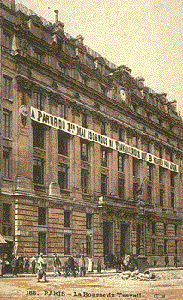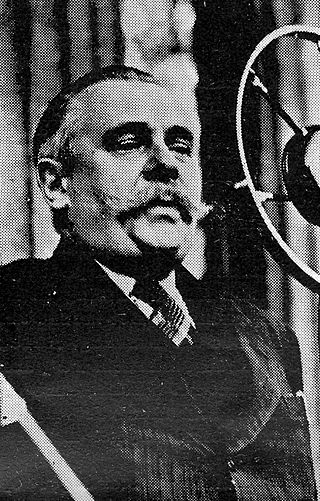
The General Confederation of Labour is a national trade union center, founded in 1895 in the city of Limoges. It is the first of the five major French confederations of trade unions.
The General Confederation of Labor - Workers' Force, is one of the five major union confederations in France. In terms of following, it is the third behind the CGT and the CFDT.

The Union syndicale Solidaires, Solidaires or Solidaires Unitaires Démocratiques (SUD) is a French group of trade unions.

Georges-Étienne Bonnet was a French politician who served as foreign minister in 1938 and 1939 and was a leading figure in the Radical Party.
The Revolutionary Syndicalist General Confederation of Labour was a French national trade union centre. It emerged out of the libertarian faction of the Unitary General Confederation of Labour (CGTU) and split away after it came under the control of the French Communist Party (PCF). The CGT-SR was established in 1926, largely on the basis of artisanal unions in southern France, and became the country's third and smallest trade union confederation. Its driving ideology was revolutionary syndicalism, which rejected political parties and upheld decentralisation as an organisational model.
A company or "yellow" union is a worker organization which is dominated or unduly influenced by an employer and is therefore not an independent trade union. Company unions are contrary to international labour law. They were outlawed in the United States by the 1935 National Labor Relations Act §8(a)(2), due to their use as agents for interference with independent unions. However, company unions persist in many countries.

The Bourse du Travail, a French form of the labour council, were working class organizations that encouraged mutual aid, education, and self-organization amongst their members in the late nineteenth and early twentieth centuries.

Pierre Monatte was a French trade unionist, a founder of the Confédération générale du travail at the beginning of the 20th century, and founder of its journal La Vie Ouvrière on 5 October 1909. Monatte has been considered one of the great figures of revolutionary syndicalism.

The Confédération générale du travail unitaire, or CGTU, was a trade union confederation in France that at first included anarcho-syndicalists and soon became aligned with the French Communist Party. It was founded in 1922 as a confederation of radical unions that had left the socialist-dominated General Confederation of Labour (CGT), and in 1936 merged back into the CGT.

Pierre Besnard was a French anarcho-syndicalist. He was the co-founder and leader of the Confédération Générale du Travail-Syndicaliste Révolutionnaire (CGT-SR) and its successor the Confédération Nationale du Travail (CNT), and the principal theoretician of anarcho-syndicalism in France during the early 20th century.
Confédération générale du travail du Burkina is a revolutionary national trade union centre in Burkina Faso. Bassolma Bazié the general secretary of CGT-B.
Trade unions in Guinea were historically important - having played a pivotal role in the country's independence movement - and in recent years have again assumed a leading role.

Gaston René Léon Monmousseau was a French railway worker, trade union leader, politician and author, from a rural working-class background. He became an anarcho-syndicalist, then a communist, and played a leading role in the French Communist Party and in the national trade union movement both before and after World War II (1939–45).

Benoît Frachon, a French metalworker and trade union leader, was one of the leaders of the French Communist Party and of the French Resistance during World War II (1939–45). He was Secretary-General of the Confédération générale du travail (CGT) from 1945 to 1967.
Paul Lapeyre was a militant anarchist, anarcho-syndicalist and free-thinker.
Pierre Ferdinand Joseph Vigne was a French trade union leader, who came to international prominence, but collaborated with the Vichy government and fell into obscurity.
The Labor Charter was a French law on labor law in France, signed on 4 October 1941, by the Vichy regime under the German occupation of France. It sought to reorganize labor relations by abolishing class struggle and promoting collaboration between workers and employers.
The Confederation of Free Trade Unions was a French trade union confederation created in the 1950s. It was considered close to employers and on the right. Initially called the Confédération française du travail (CFT), it changed its name in 1977 following public outrage after a unionist was killed by CFT members. The CSL dissolved in 2002. It was primarily active in the automobile industry, the postal service, and the city administration of Paris.
The General Confederation of Independent Trade Unions (CGSI) was a French trade union confederation created in the aftermath of World War II. It disappeared in the 1970s. The CGSI was active in sectors such as the automobile industry, the postal service, and the City of Paris administration.









